- INTERNAL - Bepoz Help Guides
- End-User | Products & SmartPOS
- Product Stock Modes
-
End-User | Products & SmartPOS
-
End-User | Stock Control
-
End-User | Table Service and Kitchen Operations
-
End-User | Pricing, Marketing, Promotions & Accounts
- Prize Promotions
- Points, Points Profiles and Loyalty
- Product Promotions
- Repricing & Discounts in SmartPOS
- Vouchers
- Account Till Functions
- Pricing, Price Numbers and Price Modes
- Raffles & Draws
- Marketing Reports
- Accounts and Account Profiles
- Rewards
- SmartPOS Account Functions
- Troubleshooting
- Product Labels
- Packing Slips
-
End-User | System Setup & Admin
-
End-User | Reporting, Data Analysis & Security
-
End-User | Membership & Scheduled Billing
-
End-User | Operators, Operator Permissions & Clocking
-
Interfaces | Data Send Interfaces
-
Interfaces | EFTPOS & Payments
- NZ EFTPOS Interfaces
- Linkly (Formerly PC-EFTPOS)
- Adyen
- Tyro
- ANZ BladePay
- Stripe
- Windcave (Formerly Payment Express)
- Albert EFTPOS
- Westpac Presto (Formerly Assembly Payments)
- Unicard
- Manager Cards External Payment
- Pocket Voucher
- OneTab
- Clipp
- eConnect-eConduit
- Verifone
- AXEPT
- DPS
- Liven
- Singapore eWallet
- Mercury Payments TRANSENTRY
- Ingenico
- Quest
- Oolio - wPay
-
Interfaces | SMS & Messaging
-
Interfaces | Product, Pricing, Marketing & Promotions
- Metcash Loyalty
- Range Servant
- ILG Pricebook & Promotions
- Oolio Order Manager Integration
- Ubiquiti
- Product Level Blocking
- BidFood Integration
- LMG
- Metcash/IBA E-Commerce Marketplace
- McWilliams
- Thirsty Camel Hump Club
- LMG Loyalty (Zen Global)
- Doshii Integration
- Impact Data
- Marsello
- IBA Data Import
- Materials Control
- Last Yard
- Bepoz Standard Transaction Import
-
Interfaces | Printing & KDS
-
Interfaces | Reservation & Bookings
-
Interfaces | Database, Reporting, ERP & BI
-
Interfaces | CALink, Accounts & Gaming
- EBET Interface
- Clubs Online Interface
- Konami Interface
- WIN Gaming Interface
- Aristocrat Interface
- Bally Interface
- WorldSmart's SmartRetail Loyalty
- Flexinet & Flexinet SP Interfaces
- Aura Interface
- MiClub Interface
- Max Gaming Interface
- Utopia Gaming Interface
- Compass Interface
- IGT & IGT Casino Interface
- MGT Gaming Interface
- System Express
- Aristocrat nConnect Interface
- GCS Interface
- Maxetag Interface
- Dacom 5000E Interface
- InnTouch Interface
- Generic & Misc. CALink
-
Interfaces | Miscellaneous Interfaces/Integrations
-
Interfaces | Property & Room Management
-
Interfaces | Online Ordering & Delivery
-
Interfaces | Purchasing, Accounting & Supplier Comms
-
SmartPOS | Mobile App
-
SmartPDE | SmartPDE 32
-
SmartPDE | Denso PDE
-
SmartPDE | SmartPDE Mobile App
-
MyPlace
-
MyPlace | myPLACE Lite
-
MyPlace | Backpanel User Guides
- Bepoz Price Promotions
- What's on, Events and tickets
- Staff
- System Settings | Operational Settings
- Vouchers & Gift Certificates
- Member Onboarding
- Members and memberships
- System Settings | System Setup
- Reports and Reporting
- Actions
- Offers | Promotions
- Messaging & Notifications
- System Settings | App Config
- Surveys
- Games
- User Feedback
- Stamp Cards
-
MyPlace | Integrations
-
MyPlace | FAQ's & How-2's
-
MyPlace | Release Notes
-
YourOrder
-
YourOrders | Backpanel User Guides
-
YourOrders | YourOrder Kiosk User Guide
-
YourOrders | Merchant App User Guide
-
WebAddons
-
Installation / System Setup Guides
- SmartPOS Mobile App | Setup
- SmartPOS Mobile App | SmartAPI Host Setup
- SmartPOS Mobile App | BackOffice Setup
- SmartPOS Mobile App | Pay@Table setup
- SmartKDS Setup 4.7.2.7 +
- SmartKDS Setup 4.6.x
- SQL Installations
- Server / BackOffice Installation
- New Database Creation
- Multivenue Setup & Config.
- SmartPOS
- SmartPDE
- Player Elite Interface | Rest API
- Interface Setups
- Import
- KDSLink
- Snapshots
- Custom Interface Setups
-
HOW-2
- Product Maintenance
- Sales and Transaction Reporting
- SmartPOS General
- Printing and Printing Profiles
- SQL
- Repricing & Discounts
- Stock Control
- Membership
- Accounts and Account Profiles
- Miscellaneous
- Scheduled Jobs Setups
- Backoffice General
- Purchasing and Receiving
- Database.exe
- EFTPOS
- System Setup
- Custom Support Tools
-
Troubleshooting
-
Hardware
2 | Stock Modes Explained
In Bepoz, there are 6 Stock Modes that can be selected when a Product is being created. This article describes those 6 different Stock Modes. The Stock Mode selected may determine whether other settings are applicable for the Product and whether or not certain data is recorded. It is not advised (and in most cases not permitted by the System) to change a Product's Stock Mode after it has been used within the database, e.g., Purchased, Transferred, Manufactured, etc.
In Bepoz, there are 6 Stock Modes that can be selected when a Product is being created. This article describes those 6 different Stock Modes.
The Stock Mode selected may determine whether other settings are applicable for the Product and whether or not certain data is recorded.
It is not advised (and in most cases not permitted by the System) to change a Product's Stock Mode after it has been used within the database, e.g., Purchased, Transferred, Manufactured, etc.
The Stock Modes are as follows and are detailed below and in additional articles: Stocked, Non-Stocked, Manufactured, Auto-Manufactured, Non-Stocked Purchase Only, Consumables.
Stock Modes Summarized & Examples
Stocked
- Any Product that is Purchased and can physically be Transferred, Counted, have its Quantity adjusted, etc. in the same unit that it is Purchased in is considered to be a Stocked Product
- There are dozens -- if not hundreds -- of examples of Stocked Products; some major categories include the following:
- Packaged Beverages
- Ingredients for menu items; e.g., produce, proteins, dairy, poultry, etc.
- Dry/canned goods
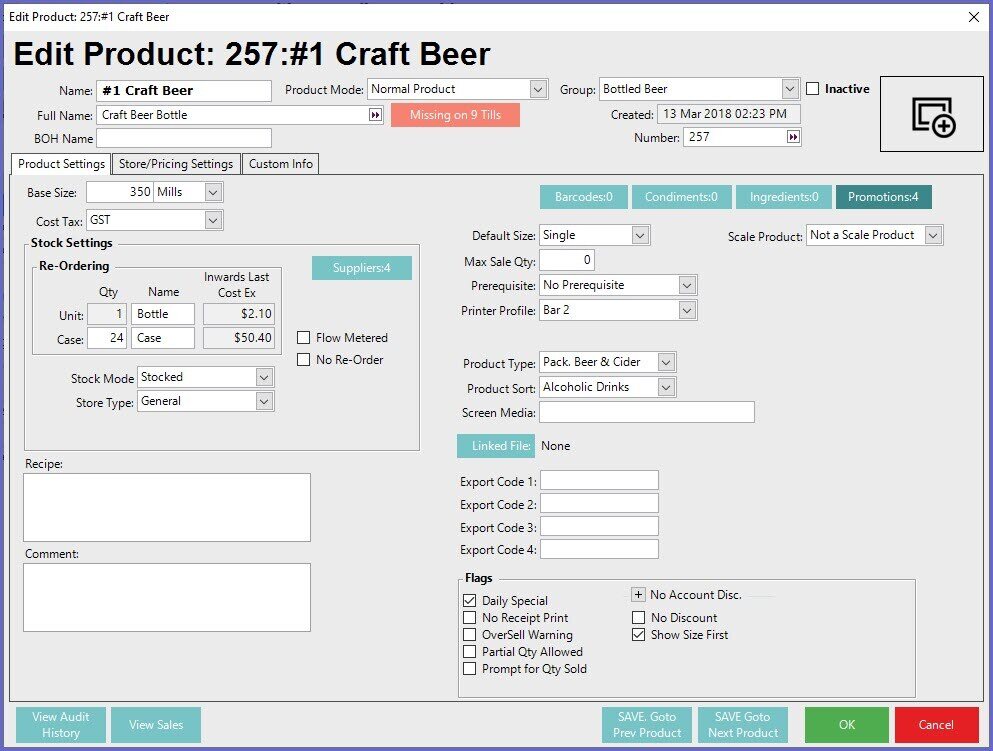
Non-Stocked
- In contrast to Stocked Products, Non-Stocked Products are Products that need to exist in the database typically for Selling purposes
- In order for a Product to be sold, it must be added to a KeyMap and in order for that to happen, a Product needs to exist in the database even if it is not Purchased as it is sold -- think of a pizza that is made up of ingredients; the ingredients are purchased (these would be Stocked Products), but the pizza itself is made to order and therefore is Non-Stocked
- In this pizza scenario, having the Non-Stocked Product in the database not only allows us to add it to a KeyMap to be sold, but it also allows us to record data and report on the Product
- It’s advised to configure Non-Stocked Products' Ingredient Products (which would typically be Stocked Products) for accurate Quantity on Hand figures of the Product's Ingredients; e.g., any time a Non-Stocked Product is sold, the Ingredient Quantities will be decremented from Stock
- Common examples of Non-Stocked Products include made-to-order cocktails, menu items, meal deals, and other package products that are added to the Product list to be sold
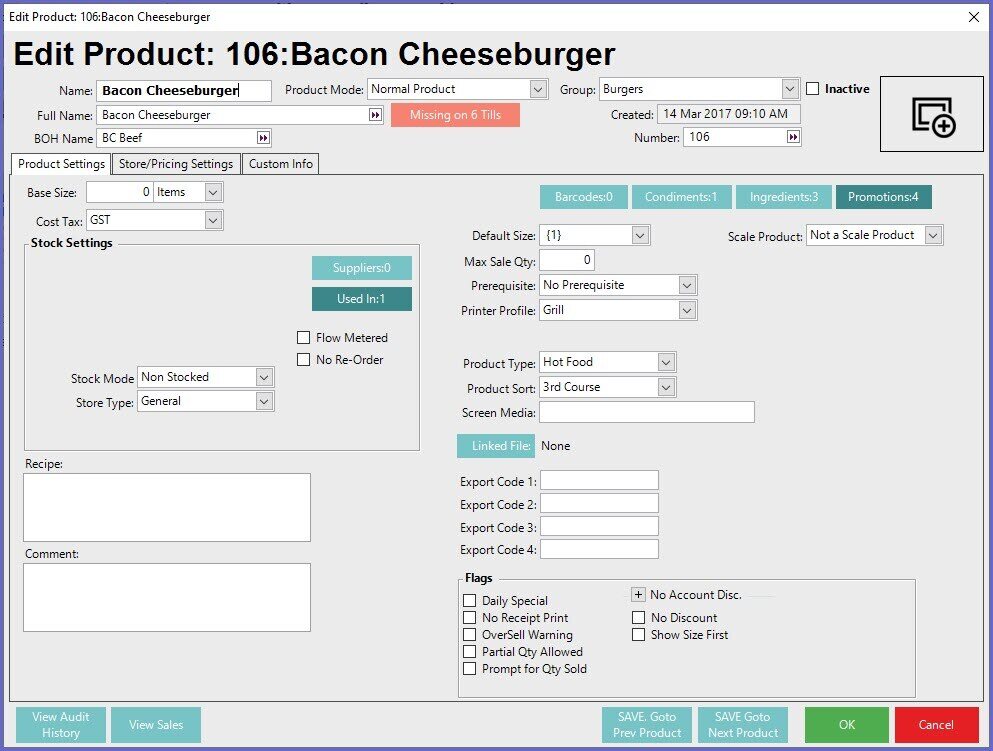
Manufactured
- Manufactured Products are items that literally have to be manufactured before they can be sold
- In contrast to Non-Stocked Products, Manufactured Products are typically not made-to-order; they are Manufactured from Ingredients (Stocked Products or other Manufactured Products)
- At the point that Manufactured Products are processed in the system, the stock is deducted from their Ingredient Products and stock is created for the Manufactured Product which makes it stockable and able to be counted
- Some examples of Manufactured Products:
- Pre-made sandwiches, salads, etc.
- Cakes, pies, and other baked goods
- Bulk cocktails such as sangria
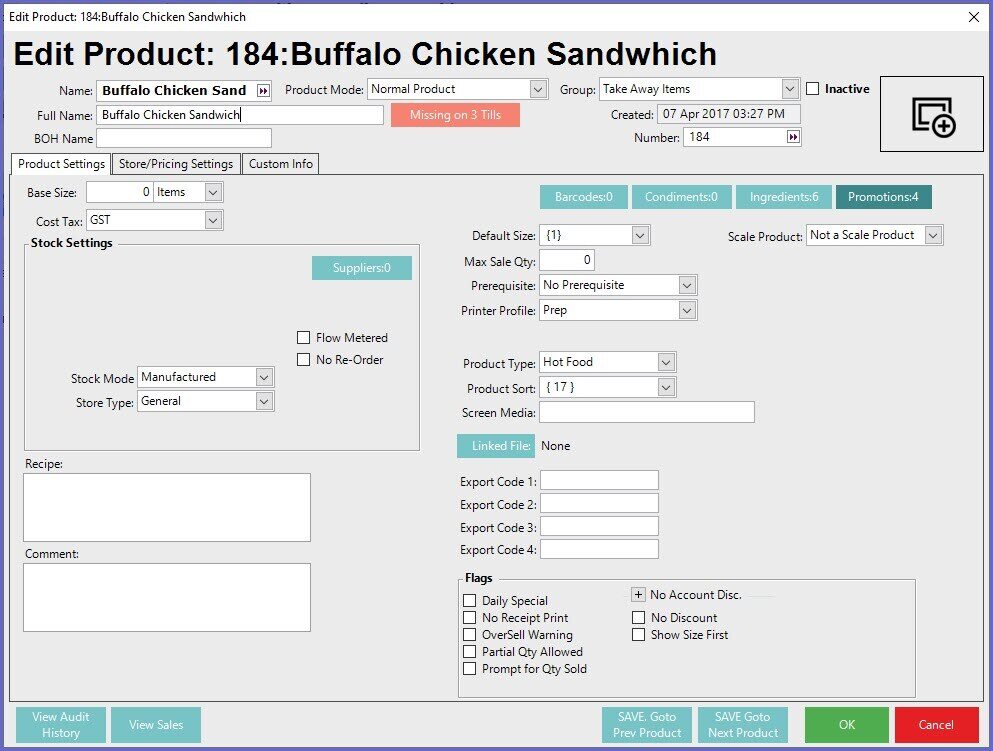
Non-Stocked Purchase Only
- In contrast to both Stocked and Non-Stocked modes, Non-Stocked Purchase Only Products cannot be Sold, Transferred, or Adjusted in any way, or be counted for Stocktakes -- as the name implies, they can only be Purchased
- As a precaution to prevent these Products from being Sold, measures have been implemented to prevent them from even being able to be added to KeyMaps
- Products of this Stock Mode can be purchased & received using the standard Purchase Order procedure, however, limited to PO types that do not involve Sales history or Quantities as these Products technically do not have any
- These Products can be credited/refunded; in other words, we can process negative purchases for them
- Since these Products are intended to be intangible or at least cannot be sold, transferred, etc., no Cost or Quantity on Hand is recorded for them
- Some examples include:
- Utilities such as electricity, gas, water, etc.
- Subscription services such as TV providers, internet providers, music/entertainment subscriptions
- Standing/recurring services; e.g., weekly linen or floor mat rentals/cleaning, fryer oil cleaning/exchange, florist, etc.
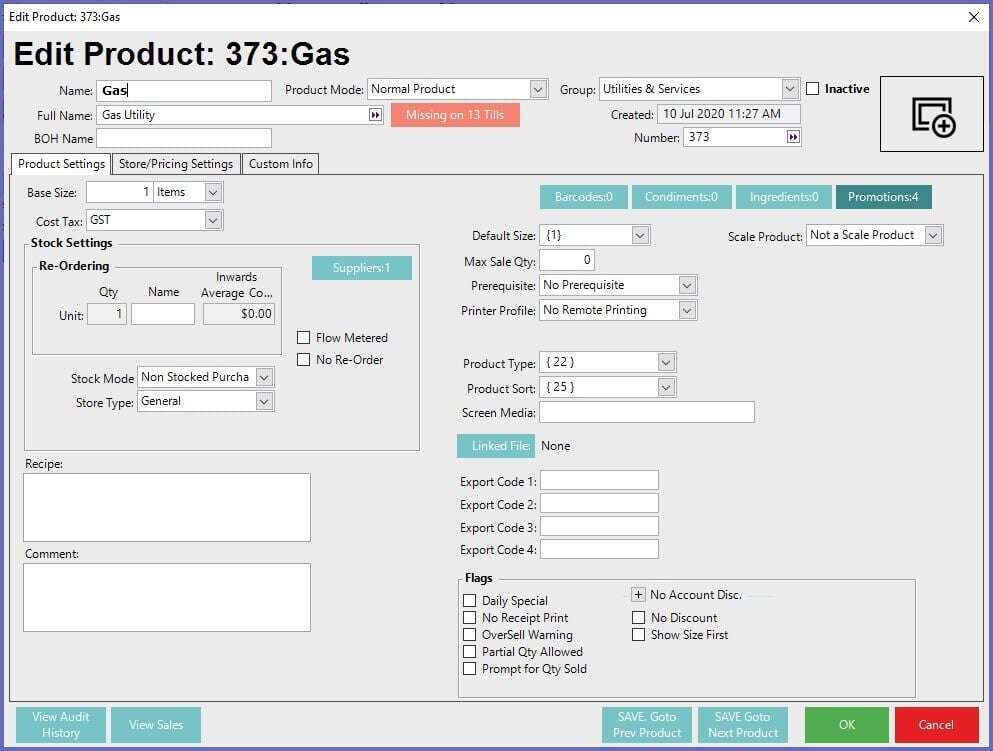
Consumables
- Just like Non-Stocked Purchase Only, Consumable Products can be Purchased and Received, however, they cannot be sold
- Measures are in place to prevent them from being added to KeyMaps
- However, similar to Stocked Products, Consumables can be Transferred, Qty Adjusted, counted for Stocktakes, and so on
- Products with the Consumable Stock Mode do have Quantity on Hand and Cost on Hand recorded and reported on
- Consumables aren’t sold but rather used as part of daily operations and as such we account for their costs by reporting on their Usage Quantity and Usage Costs
- Some possible examples may include the following:
- Napkins, single-use cutlery, straws, etc.
- Take-away containers & bags (although these may be managed as Stocked Products and included as ingredients for a Non-Stocked or Manufactured Product)
- Back-of-house disposable goods; e.g., plastic wrap, baking paper, aluminum foil, gloves, etc.
- Equipment/supplies that the business would like to count & track quantity/costs such as bar supplies, cut gloves, etc.
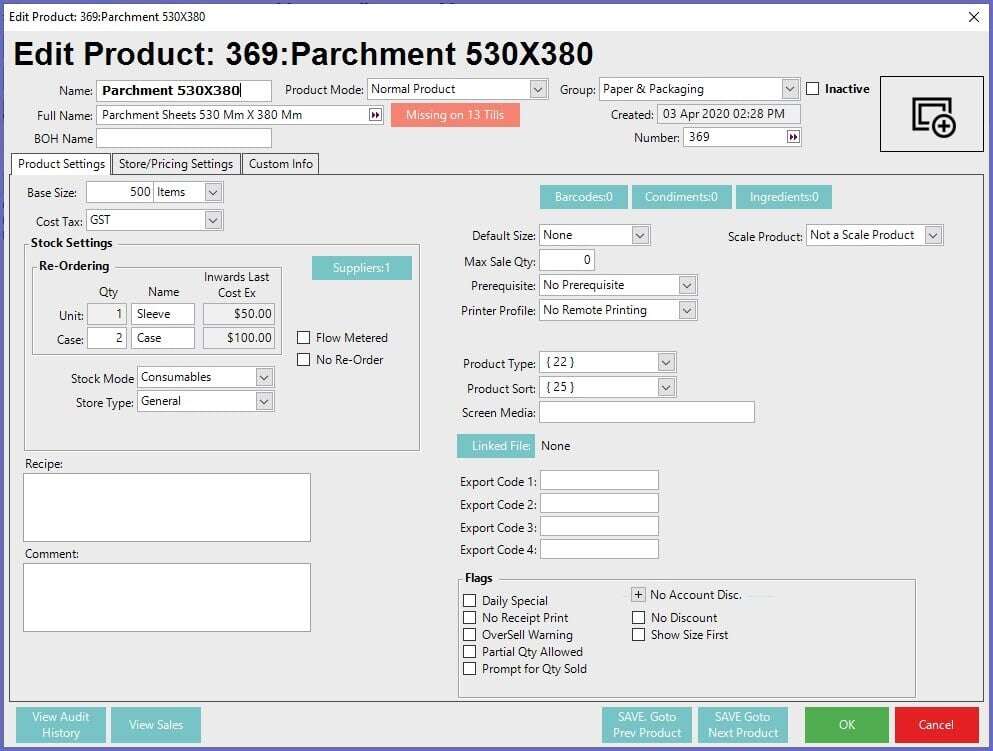
Auto-Manufactured
- Auto-Manufactured Products are used for cases where there may be insufficient or No Quantity on Hand to Manufacture a base Manufactured Product
- This comes in handy for Nested Manufactured Products wherein one Manufactured Product is an ingredient of another Manufactured Product
- For example:
- There may be a pre-made sandwich that is sold which is a Manufactured Product
- That sandwich may include a house-made sauce which is also a Manufactured Product (a "nested" Manufactured Product)
- The sauce could be configured as Auto-Manufactured as it may only be Manufactured along with the sandwich
